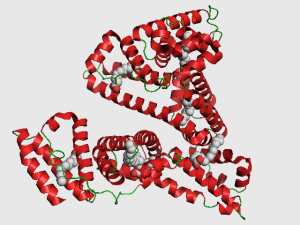Synthesized by the liver, the serum albumin used as carrier for many ligand and plays a crucial role in maintaining the oncotic pressure of plasma. This is by far the most abundant protein in serum (60% serum protein).

Indications:
• Diagnosis of liver failure at a hepatobiliary disease.
• Confirmation of the diagnosis of nephrotic syndrome before edema with proteinuria.
• Review malabsorption discovered during chronic diarrhea.
Sample:
Blood collected on dry or heparinized tube.
Typical values:
35 to 50 g / L
In children under 1 year:
35 to 40 g / L
Interpretation:
Hyperalbuminemia:
The Hyperalbuminemia is indicative of an extracellular dehydration.
Hypoalbuminemia:
Hypoalbuminemia shows either a summary of failure or urinary or digestive protein-losing.
Decreased synthesis:
Hypoalbuminaemia may be due to malnutrition.
It is mainly caused by liver failure which hypoalbuminemia, with the lowering of the factors of the prothrombin complex, the best sign.
Protein loss:
Urinary albumin losses realized nephrotic syndrome, where albumin> 30 g / L is associated with proteinuria> 3 g / day (50 mg / kg / day in children) (see Proteinuria).
Digestive albumin losses are due to malabsorption.
The hypoalbubinémie is particularly marked in the malabsorption of chronic enteropathy – celiac disease, Whipple’s disease, short bowel, intestinal lymphoma – usually discovered during the assessment of chronic diarrhea.
Two malabsorption to know:
Celiac disease results in adults by diarrhea, abdominal pain and in 20% of cases, with hypoalbubinémie malabsorption, anemia, folate deficiency … Finding transglutaminase (anti-tTG-IgA) and endomysial contributes to the diagnosis.
Intestinal lymphangiectasis strikes children and young adults. It is revealed by edema and diarrhea. The hypoalbubinémie is accompanied by a decrease of immunoglobulins, transferrin and ceruloplasmin.

You must be logged in to post a comment.